
Sensors in Military & Defense Equipment
An overview of sensors for military surveillance equipment and encrypted communication devices
In modern warfare, protection of personnel, weapons and infrastructure is essential. Advanced sensor technologies play a key role in rapid detection and confirmation of potential threats, enabling immediate mitigating responses. We’ll explore applications of these advanced sensors in two critical areas: military surveillance equipment and encrypted communication devices. By leveraging these sophisticated tools, defense organizations can monitor activities in sensitive areas, provide secure communication, and enhance operational effectiveness to protect vital resources against evolving threats.
Military Surveillance Equipment
Modern armed forces employ advanced sensor technologies to monitor activities in sensitive areas both behind the lines and on the battlefield. These sensors enable protection of personnel, weapons and critical infrastructure. This section explores the diverse array of sensors available for battlefield deployment and monitoring activities in sensitive areas. Strategic combinations of technology can confirm perceived threats while enabling the safety of friendly forces and bystanders. Defense organizations leverage these sophisticated capabilities to maximize their effectiveness and safeguard vital resources against a range of security challenges.


Photoelectric Sensors
Photoelectric sensors come in various forms, including through-beam, retro-reflective, and diffuse-reflective types. Through-beam sensors have separate emitter and detector units that detect interruptions in the beam, while retro-reflective sensors incorporate the emitter and detector in a single device, using a reflector to redirect the beam back to the unit. Diffuse-reflective sensors also use a single unit, with the object itself acting as the reflector.
Accelerometers
Accelerometers detect and measure vibrations in various applications. These devices operate based on mechanical, electromagnetic or optical principles. They detect intrusions on perimeter security by monitoring vibrations on fences, walls or other barriers. Vibration sensors detect imbalance, misalignment or wear in vehicles or other mechanical equipment issues that help predict potential failures. Vibrations from footsteps, vehicles or tunneling activities can be detected, alerting security personnel of possible threats.
These durable, versatile devices are highly sensitive, making them effective for monitoring subtle vibrations. Continuous, real-time data allows for instant response. However, vibration sensors are prone to false alarms by non-threatening vibrations such as wind or nearby machinery. They have a limited range, and the power consumption may be objectionable in some cases. Recently, micro electromechanical systems (MEMS) technology has expanded the range of applications for accelerometers by making them smaller, lighter, more power-efficient, cost effective, robust and versatile.
Encrypted Communication Devices
Military and defense organizations rely on a variety of encrypted communication devices to provide secure and reliable communication. Devices such as handheld radios, computers, airborne communication systems, key loaders and encryptors depend on sensors for tamper detection and environmental monitoring. Protecting the integrity of these devices is critically important for the safety and effectiveness of personnel and equipment.


Data Integrity
Sensors that monitor environmental conditions, such as temperature or humidity can trigger protocols to help prevent data corruption. For example, switching to backup systems or initiating integrity checks can help prevent data loss in critical communication systems. Voltage sensors detect power supply fluctuations that may indicate environmental stress or tampering. When anomalies are detected, security protocols such as data encryption or system shutdown can preserve data integrity.
Data Confidentiality
Tamper detection sensors detect physical tampering attempts. If tampering is detected, the system can trigger data encryption or key erasure protocols, thus reducing the chances of unauthorized access to sensitive information.
Enabling Future Readiness
Integration of advanced sensor technologies in military surveillance equipment and encrypted communication devices has become a fundamental part of modern defense strategies. These technologies not only enhance the detection and response capabilities of defense organizations but also confirm the protection of critical assets and personnel. As security threats continue to evolve, the ongoing development and deployment of sophisticated sensors will be essential in maintaining a strategic advantage and safeguarding national security. By staying at the forefront of technological advancements, defense organizations can effectively address emerging challenges and secure a safer future.


